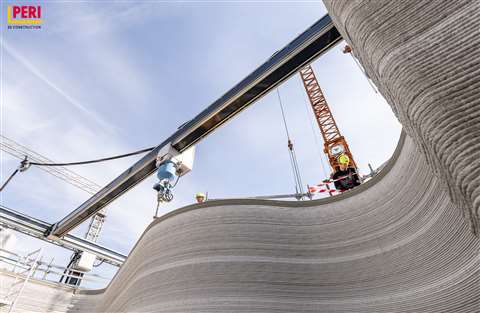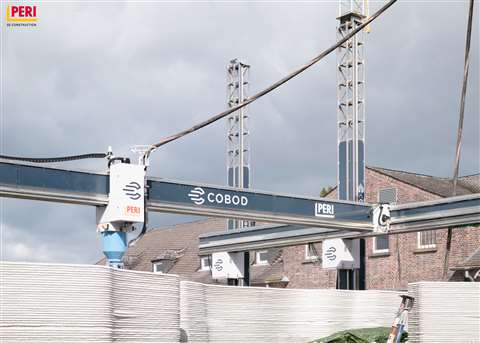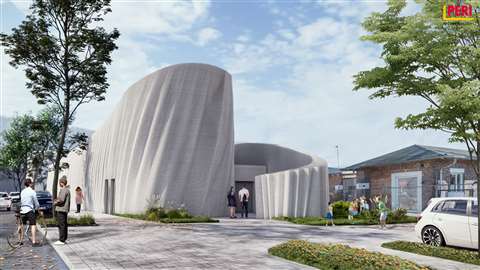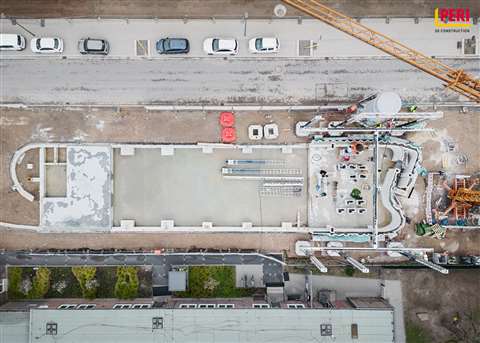Images | Europe’s largest 3D-printed building under construction
04 May 2023
 Europe’s largest 3D-printed building under construction in Heidelberg (Image: Peri/Cobod)
Europe’s largest 3D-printed building under construction in Heidelberg (Image: Peri/Cobod)
German construction company Kraus Gruppe is using a 3D printer to construct Europe’s largest 3D-printed building in the city of Heidelberg.
The construction firm is using Cobod’s BOD2 printer. The machine will print walls for the building, which is almost 600 sq m in area (6600 sq ft), 54m (162 ft) long, 11m (121 ft) wide and 9m (30 ft) high.
The building will become a ‘server hotel’ for data centre provider Heidelberg IT Management.
Formwork and scaffolding specialist Peri’s 3D construction arm will provide the know-how for the construction, which involves using 200 cubic metres of pumpable concrete.
The high-speed BOD2 printer can print 4 sq m of building per hour and the entire process of printing the walls of the building is expected to take 140 hours in total. Because of the size of the building, the printer will have to be moved several times during the process.
 Europe’s largest 3D-printed building under construction (Image: Peri/Cobod)
Europe’s largest 3D-printed building under construction (Image: Peri/Cobod)
Without 3D printing, the unusual design of the walls would have required bespoke formwork, which Cobod said would have made the project “incredibly expensive”.
The printed layers of the building, completion of which is due in July this year, will be left exposed on the exterior.
Architects from SSV Architekten and Mense Korte designed the server hotel.
Limit to 3D building height
It is the latest and largest 3D-printed building to be constructed using 3D printers from Denmark-based Cobod. After building Europe’s first 3D-printed building in 2017, Cobod printers were used to construct the first 2- and 3-storey buildings in Europe (Belgium & Germany), North America (US & Canada) and India.
However, there is a limit to how large buildings can get using Cobod’s 3D printing system – the BOD2 robot is unable to build past 9m in height. Cobod said it was working on new technology to allow it to print at taller heights.
 Digital render of how the 3D-printed building will look (Image supplied by Cobod)
Digital render of how the 3D-printed building will look (Image supplied by Cobod)
Cobod is privately owned by General Electric, Cemex, Holcim and Peri as key shareholders. Other partners include Dar Al Arkan (Saudi Arabia), L&T Construction (India), JGC (Japan), Siam Cement (Thailand) and Orascom (Egypt).
Dr. Fabian Meyer-Brötz, managing director of Peri 3D Construction said, “Based on parametric design, the special wall design used in the building documents the immense design freedom, that the Cobod BOD2 3D printer enables. We are very proud to be able to realize our largest building to date with this project.”
Henrik Lund-Nielsen, founder and general manager of Cobod added, “In this unique project Peri is emphasizing two of the key benefits of 3D construction printing; speed of execution and design freedom. Because of this our technology is capable of carrying out everything from materials savings windmill towers over low cost residential housing in Africa to architectural office type buildings in Germany.”
 Aerial view of the construction of the server hotel in Heidelberg, Germany (Image: Peri/Cobod)
Aerial view of the construction of the server hotel in Heidelberg, Germany (Image: Peri/Cobod)



